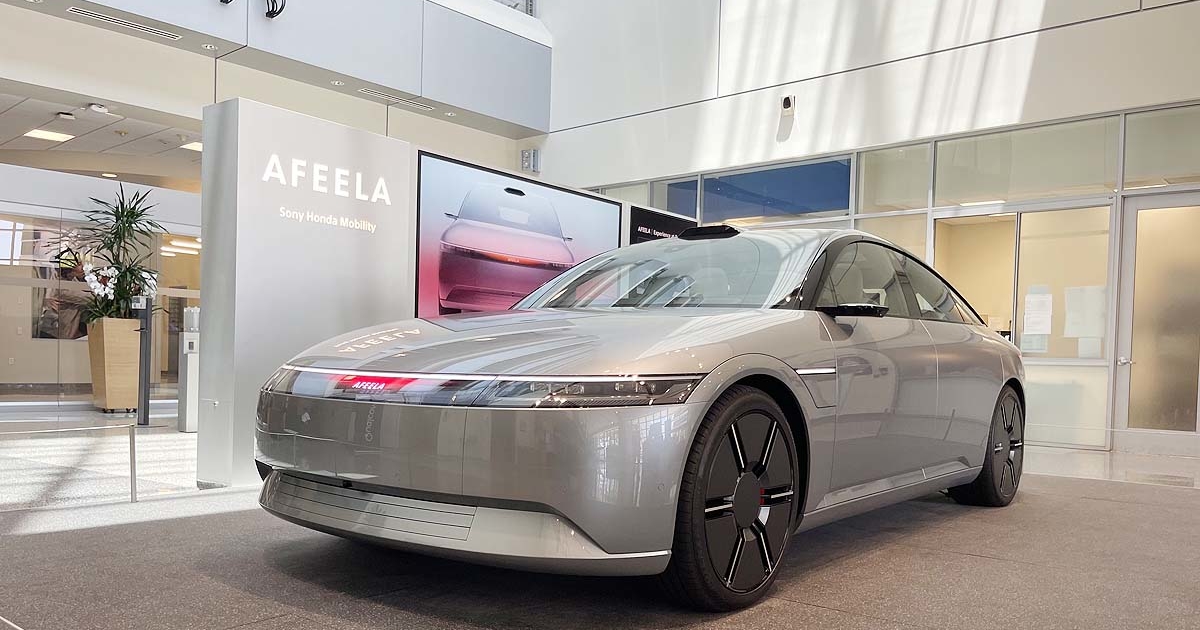
Afeela, the new electric vehicle joint venture between Honda Motor Co. and Sony Corp., still has some details to reveal — like how the high-tech cars will be sold, who will sell them and where they’ll go for service. But for now, the development project is taking shape as an aspirational brainchild of the two Japanese manufacturers.
Honda and Sony, both giants in their respective industries, are essentially creating a computer on wheels that can be personalized like a smartphone, socialize like a social media platform and make driving decisions like a human.
The joint venture, aptly named Sony Honda Mobility, is operating independently of the two marquee brands, dividing project responsibilities based on individual strengths.
But to bring their vision to life, Honda and Sony are also relying heavily on a more silent third partner: semiconductor and AI producer Qualcomm Technologies.
Qualcomm will supply the vehicle’s high-spec microprocessor set, called the Snapdragon Digital Chassis. Snapdragon is capable of 800 trillion operations per second. By comparison, chips in today’s cars usually range from 10 trillion to 50 trillion operations per second.
The Afeela EV will have 45 sensors, including lidar, eight cameras, expansive interior screens and built-in AI.
All of the sensors and cameras, in theory, will enable Level 3 self-driving capabilities. The interior displays serve as information centers and entertainment for the drivers and passengers, including movie-watching abilities from every seat. And the EV will learn more about the driver as it collects real-time data.
But they don’t work without the Qualcomm’s Snapdragon digital chassis, which includes Snapdragon Ride, the autonomous ride platform; Snapdragon connectivity, the 5G cellular and Wi-Fi connectivity; and Snapdragon digital cockpit, the screens and outside cameras and displays.
Its deep involvement in the Honda-Sony project illustrates Qualcomm’s burgeoning interest in the auto industry. The San Diego tech giant has become so adept at working on car technologies that it’s looking more like an automotive company, according to Bill Pinnell, vice president of product management for Qualcomm.
“We see the importance of diversity and moving away from a mobile-centric company, or purely mobile centric to have adjacent businesses that can use all the bits and pieces we already did with communications,” Pinnell told Automotive News.
“AI is super important, as are all the display graphics multimedia technologies that we’ve developed over the years, so the automotive part is a superset of nearly everything we do,” he said, noting that the Afeela is one of the few “devices” that uses all Qualcomm’s technologies in one, including the communications to the cloud and cloud infrastructure.
For the human-machine interface, Sony will use Qualcomm’s Epic Games’ Unreal Engine, a real-time 3D creation tool for visuals and immersive experiences, Pinnell said.
“That is taking what used to be gaming technology and putting it into the car,” he said. “Because as a car user, you want something that is going to delight you — you want eye candy.”
Pinnell said they call the screens inside the vehicle “wall-to-wall glass,” and Qualcomm is working on some of the high-end designs, such as the Mercedes-Benz 214, that require chip technology to drive more pixels than in an 8K screen.
Qualcomm is such a critical part of the EV’s execution that to some industry watchers, the Afeela seems more like a Qualcomm vehicle than a product from Sony Honda Mobility.
“Honda’s providing the platform on which to put all this stuff, and Sony’s got the ideas, but it’s really Qualcomm that’s powering all this stuff,” Ed Kim, chief analyst at AutoPacific, told Automotive News.
Honda will assemble the electric sedan in North America at one of its plants in Ohio, where it is constructing an EV production hub. It will ride on Honda’s soon-to-debut e:Architecture platform. Sony will contribute a span of digital technologies and media content derived via its movie, music and video gaming units.
Sony Honda Mobility said production of the Afeela EV will start in 2025, and deliveries will start in 2026. The car will be exported from the U.S. to Japan, its secondary market. It will be a low-volume, niche product, and pricing is still undetermined.
Outside the vehicle will be what the project is calling the “media bar.” It’s a screen that stretches horizontally between the headlights and taillights.
It’s the most futuristic-looking accessory on the EV and can be controlled through the user’s smartphone – the “command center” – to toggle between themes such as Spider-Man and Fortnite, and weather and sports updates.
Charging status also can be displayed to signal to other drivers how long they may have to wait for an occupied charge port.
One strange feature will be the option to display advertising from a third party. Sony Honda has no details on how that might entice the driver to select that setting or how it would lure engagement from passersbys.
Kim believes Afeela is far from a guaranteed project.
“All the things they’re talking about are technically feasible,” Kim said. “But the real trick is going to be the execution.”
The technology is sophisticated and imaginative, he said, “but it’s not guaranteed to initially work as intended.”
It is also possible that Afeela will launch with only some of its technologies, with customers understanding that they would obtain others in time through over-the-air downloads and updates.
“And that’s one of the things about connected cars,” Kim added. “The intent is to continue providing revenue opportunities to the automaker and technology providers as the car goes through its life cycle.”

